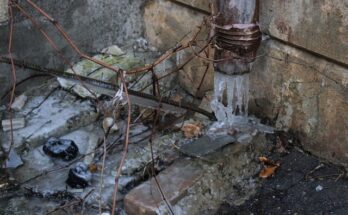That gelatinous rust-colored slime can also show up around your faucet, toilet tanks, shower fixtures, and in and around other plumbing fixtures.
This red substance is iron ochre. It is a waste product from a kind of bacteria, iron bacteria to be specific. It is a naturally occurring bacteria.
It’s not a coincidence that it looks like rust. It essentially is rust because it comes from the oxidization of minerals dissolved in the water. Oxidization is “rusting”.
Water typically has ferrous iron but also might have manganese in it, and tiny bacteria oxidize it and leave the red iron ochre.
Why is this a problem?
Iron ochre creates a thick slime. This slime is partially problematic by itself because as it attaches to the insides of pipes it affects the flow of water.
This slime will show up at the end of the faucet, on screens in your washer and dryer, or inside tanks and plumbing. As it builds up it can begin to corrode pipes and other metal equipment that it touches. It can even damage stainless steel.
As the corrosion grows, the iron ocher begins to block the pipe and affect the flow. And left unchecked for too long, it can cause pieces of metal from the pipe to break away. These float further down the pipe stream and become lodged, causing blockages, or spreading the corrosion.
When there is iron bacteria in your water it can cause a host of household problems. First of all it may permanently damage loads of laundry or even just specific items in a given load. Second if there is a great deal of iron bacteria available in your water, your standing water might have a slight sheen on it. And no one wants to wash dishes in that!
Additionally, iron bacteria gives off a very distinct smell. It is a musty, earthy odor that people understandably associate with decay and rot, not one you would expect in a healthy home.
Finally, the presence of iron ochre increases the chance for other bacteria to grow. And while iron bacteria is not associated with any health issues, other bacteria can cause illness.
How can you prevent the problem?
If you see the telltale red slime, or perhaps a related mustard-colored slime, ask your plumber or a waterproofing expert to take steps immediately.
When your waterproofer arrives he or she will be able to tell right away whether it’s iron ochre, however they will likely perform a simple test just to be sure.
Then they will take steps to remove the standing water wherever they can. This will include improving drainage, installing bacteria resistant drain covers, and perhaps resloping or retiling a portion of your floor.
Of course, the most important part of the work is finding the source of the water entering your basement and working to stop it. This can involve plumbing, improved drainage, waterblocks, pumps, or even foundational work.
If you see red slime in your space, call an expert right away.



